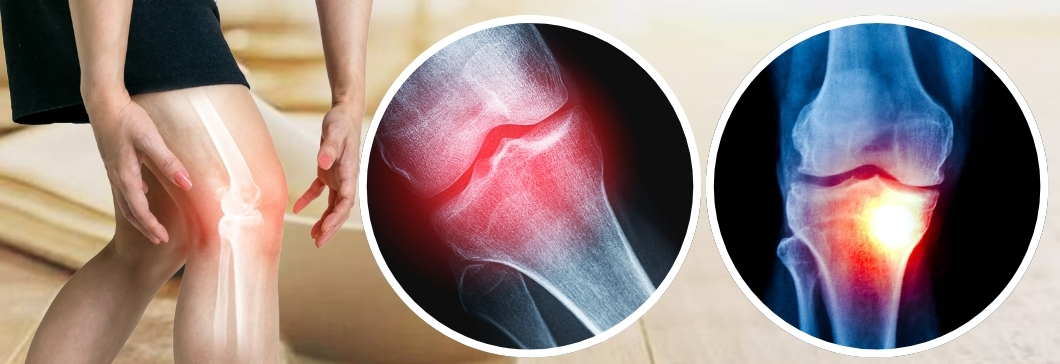Blog
Ayurveda for Osteoarthritis Pain: Find Lasting Relief Naturally

Are you waking up to stiff, painful joints? You're not the only one experiencing this discomfort. Osteoarthritis affects millions worldwide, mostly in people 50 years of age and older. But it is likely to occur in younger ones, too. While modern medicine provides treatments, Ayurveda offers a comprehensive approach to managing osteoarthritis and regaining an active lifestyle.
Hello! I'm Dr. Geeta Patil, and I'm excited to share this in-depth guide on osteoarthritis through Ayurvedic principles. Let's explore together the causes, symptoms, diagnosis, treatments, and Ayurvedic perspectives for managing osteoarthritis.
Understanding Osteoarthritis: The Common Cause of Chronic Joint Pain:
Osteoarthritis (OA) is a chronic joint condition characterized by the gradual breakdown of cartilage, the protective tissue between bones. As cartilage wears away, bones may begin to rub against each other, leading to pain, stiffness, and reduced mobility. Osteoarthritis commonly affects weight-bearing joints like knees, hips, and hands, and is often associated with aging, joint injury, or other underlying conditions.
Causes and Development of Osteoarthritis:
Osteoarthritis develops when the natural cushioning between joints, known as cartilage, breaks down over time. This breakdown can occur due to a combination of factors, including:
- Aging: As people age, the cartilage in their joints may naturally deteriorate, increasing the risk of osteoarthritis.
- Joint Injury: Previous injuries to a joint, such as fractures or ligament tears, can increase the likelihood of developing osteoarthritis later in life.
- Overuse: Repetitive stress on a joint, often from certain occupations or sports activities, can contribute to cartilage breakdown and the development of osteoarthritis.
- Genetics: Some individuals may be predisposed to osteoarthritis due to genetic factors, although the specific genes involved are still being studied.
- Obesity: Excess body weight places added stress on weight-bearing joints, such as the knees and hips, increasing the risk of osteoarthritis.
- Joint Misalignment: Abnormalities in joint structure or alignment can alter the distribution of weight and contribute to cartilage wear and tear.
- Other Factors: Hormonal changes, inflammation, and metabolic disorders may also play a role in the development of osteoarthritis.
Symptoms of Osteoarthritis:
- Joint Pain: Worsens with activity, improves with rest.
- Stiffness: Especially after inactivity, improves with movement.
- Swelling: Around affected joints.
- Reduced Range of Motion: Difficulty moving the joint fully.
- Joint Instability: Feeling of joint giving way.
- Grating Sensation: Crepitus within the joint.
- Muscle Weakness: Due to pain or disuse.
Ayurvedic View of Osteoarthritis:
In Ayurveda, osteoarthritis is known as “Sandhigata Vata,” involving Vata dosha imbalance and impaired digestion leading to toxin accumulation in joints.
Ayurvedic Treatment for Osteoarthritis:
Panchakarma Therapies:
Abhyanga, Swedana, Basti, Virechana help balance doshas, reduce inflammation, and improve joint health.
Herbal Remedies:
Guggulu, Ashwagandha, Turmeric, Shallaki reduce inflammation and support joint health.
Dietary Modifications:
Warm, cooked foods, whole grains, lean proteins, healthy fats, and warming spices. Avoid cold, raw, processed foods, and excessive caffeine and alcohol.
Lifestyle Changes:
Engage in regular low-impact exercises such as walking, swimming, or yoga to improve joint flexibility and strength. Maintain a daily routine that includes adequate rest, sleep, and stress management practices. Protect affected joints from cold and damp weather.
Ayurvedic Oils:
Topical application of oils like Mahanarayan oil reduces pain and inflammation.
Role of Janu Basti:
Janu Basti involves applying warm medicated oil to the knee joint, alleviating pain, reducing inflammation, and promoting healing.
Yoga:
Regular yoga practice can help improve joint flexibility, reduce stiffness, and alleviate pain associated with osteoarthritis.
Lifestyle for Osteoarthritis:
In addition to medical treatments and Ayurvedic therapies, lifestyle modifications play a crucial role in managing osteoarthritis and improving overall joint health. Here are some lifestyle changes that can help individuals with osteoarthritis:
Maintain a Healthy Weight:
Excess weight increases joint strain, so aim for a healthy weight to reduce pressure on joints.
Stay Active:
Engage in low-impact exercises like walking or swimming to keep joints flexible and muscles strong.
Protect Your Joints:
Use proper body mechanics during daily activities and consider assistive devices if needed.
Practice Good Posture:
Maintain proper posture to alleviate strain on joints, especially the spine.
Manage Stress:
Stress can worsen symptoms, so practice relaxation techniques like deep breathing or meditation.
Stay Hydrated:
Drink plenty of water to keep joints lubricated and functioning optimally.
Eat a Balanced Diet:
Opt for a diet rich in fruits, vegetables, lean proteins, and healthy fats to reduce inflammation.
Listen to Your Body:
Pay attention to your body's signals and adjust activities accordingly to avoid overexertion.
Conclusion:
Osteoarthritis is a condition that requires comprehensive management. With Ayurveda's approach, individuals can address the root causes and improve their quality of life. Sanjeevani Ayurveda offers personalized treatment plans tailored to individuals to effectively manage osteoarthritis and promote overall well-being.
Wishing you strength and mobility,
Dr. Geeta Patil
Sanjeevani Ayurveda

